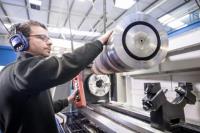 Add My Company
Add My Company
Sign In

This is a part that has been trepanned.
“I thought a trepanning tool was an unpleasant medical device from the 19th century! I didn’t know it was also a manufacturing process!”
When Jo asked if she could feature Hone-All Precision, our director, Andrea Rodney, suggested that the focus of the feature should be Trepanning.
Jo only knew this word as a form of surgery in which a hole is bored into the skull. However, there is another, less well-known, industrial application for drilling large deep holes in metal parts whilst still retrieving a valuable core.
It can be used in many industries, including Oil & Gas and Aerospace, where bores may be required in components or if there is insufficient horsepower to drive solid drilling tools.
This application is also recommended if there is a through bore or long design, which makes it ideal for specialists in deep hole drilling, honing and turning up to 3 metres long - like Hone-All.
Sometimes the trepanned hole is fit for use as bored but often it is meant to be a roughing operation to be machined to a closer tolerance or honed through for a good surface finish and improved geometry.
So, What Does A Trepanning Tool Do?
Andrea explained that this form of cutting machine has two uses:
1. It can remove a solid core from a piece of round bar or material. For example, a customer has a 300mm diameter bar but the design requires a 200mm hole up the middle of it. The tool can trepan that material out and give them back the solid core, rather than chippings or swarf. This means that the slug can be used to make another component instead of becoming waste.
Say you had a pre-op 200mm bore out but tight tolerance means that the company cannot get up to that size, a trepanning device would be used to do a rough cut to remove the majority of the material in the most effective manner.
2. Alternatively, imagine a bar with a big flange on the end. So, you have a 400mm diameter bar but most of it needs to be turned down to 200mm. You could use the trepanning tool to part off the outer sleeve.
It would take numerous passes to remove 200mm from the outside diameter of a bar. So, rather than turning for hours and removing a huge amount of material as swarf, it is possible to use one machine process to produce a solid sleeve that can be used again.
For more information on The Trepanning Tool – A Modern Manufacturing Moneysaver talk to Hone-All Precision Ltd
Enquire Now
List your company on FindTheNeedle.

